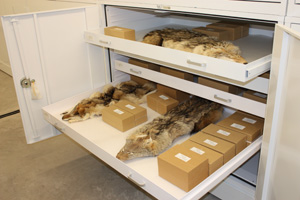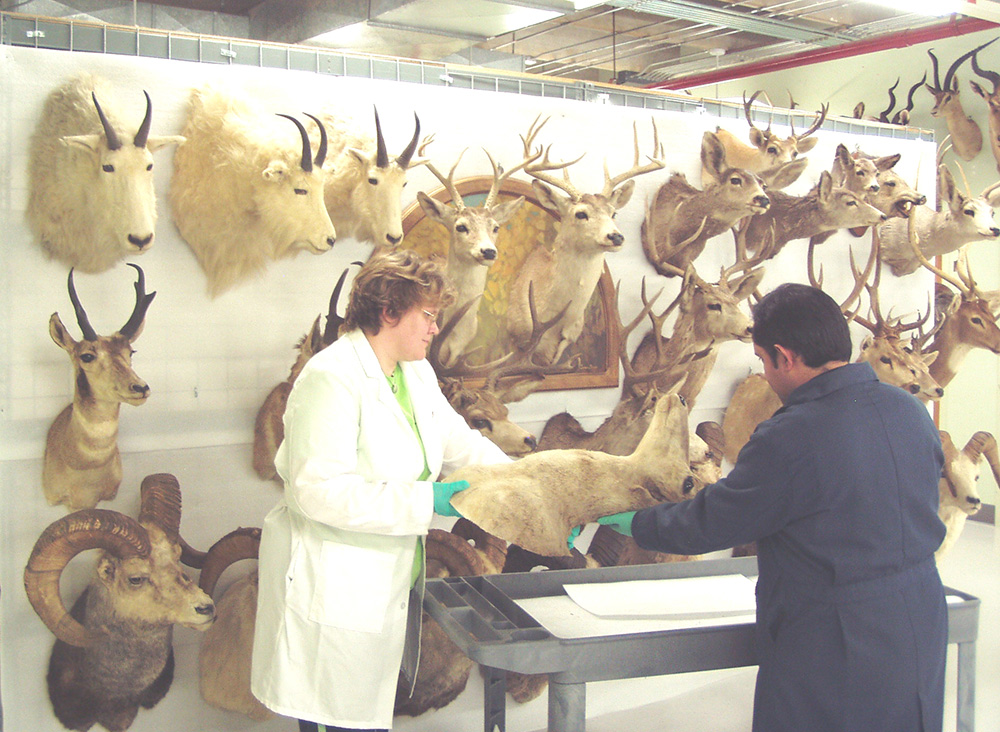Mammal Collection
 The NSRL's mammal collection houses more than 156,000 voucher specimens, and continues
to expand in size and in taxonomic and geographic diversity. The Mammal Collection
represents a permanent record of the natural history of Texas and the United States
in general. In addition, through the efforts of faculty, research associates, and
students of Texas Tech University, the fauna of many other countries, such as former
Yugoslavia, Paraguay, Mexico, and Peru, are represented in the collections. In recent
years, multiple studies have been conducted in Ecuador, Honduras, Malaysia, the Ukraine,
and other regions of the world, as well as continuing throughout Texas and the southwestern
U.S.
The NSRL's mammal collection houses more than 156,000 voucher specimens, and continues
to expand in size and in taxonomic and geographic diversity. The Mammal Collection
represents a permanent record of the natural history of Texas and the United States
in general. In addition, through the efforts of faculty, research associates, and
students of Texas Tech University, the fauna of many other countries, such as former
Yugoslavia, Paraguay, Mexico, and Peru, are represented in the collections. In recent
years, multiple studies have been conducted in Ecuador, Honduras, Malaysia, the Ukraine,
and other regions of the world, as well as continuing throughout Texas and the southwestern
U.S.

Nearly 80 percent of the specimens are in the form of dried skin and/or skull and skeletal material preparations, while the rest are fluid-preserved specimens housed in a separate collection area. The dried skin and skeletal preparations are stored in 650 metal cabinets. These cabinets are specially designed to keep the specimens safe from UV light, dust, occasional insect pests, and other harmful agents. The cabinets are mounted on compactor rails to maximize storage capacity.
 The Mammal Collection includes a collection of holotype specimens (see photo, top
left). Holotype specimens are among the most scientifically valuable specimens in
a collection, as they are used, through comparison, to verify the identification of
other specimens thought to be the same species or subspecies. Holotype specimens at
the NSRL are stored under lock and key in a separate location from the rest of the
mammal collection and are protected by strict rules for their use.
The Mammal Collection includes a collection of holotype specimens (see photo, top
left). Holotype specimens are among the most scientifically valuable specimens in
a collection, as they are used, through comparison, to verify the identification of
other specimens thought to be the same species or subspecies. Holotype specimens at
the NSRL are stored under lock and key in a separate location from the rest of the
mammal collection and are protected by strict rules for their use.
 Every specimen is labeled with information concerning its species, sex, collector,
preparator, collecting location, and other pieces of collecting data. Each specimen
has also been given a catalog number and its data verified and entered into our searchable
Vertebrate database. Specimens are housed in taxonomic order, so that all specimens
of the same species are stored together. Within a species, specimens are further organized
by country, state, county, and finally catalog number. As with the Genetic Resources
Collection, specimens in the Mammal Collection are barcoded to improve efficiency
in processing and maintaining an organized collection.
Every specimen is labeled with information concerning its species, sex, collector,
preparator, collecting location, and other pieces of collecting data. Each specimen
has also been given a catalog number and its data verified and entered into our searchable
Vertebrate database. Specimens are housed in taxonomic order, so that all specimens
of the same species are stored together. Within a species, specimens are further organized
by country, state, county, and finally catalog number. As with the Genetic Resources
Collection, specimens in the Mammal Collection are barcoded to improve efficiency
in processing and maintaining an organized collection.
Loan Policy
The current Loan Policies and Procedures of the NSRL may be downloaded here. (Revised 19 July 2016)
To download the appropriate application for your loan please use the following links:
Genetic resources loan application
Once completed, loan applications for the Genetic Resources should be submitted to the Curator of Genetic Resources, Dr. Caleb Phillips, and specimen-based loan applications should be submitted to the Director of the NSRL, Dr. Robert Bradley, for approval.
For help preparing the vertebrate loan application, specimen information, or questions about loan procedures, please contact the Curator of Collections, Heath Garner, (806) 834-7641 or (806) 742-2486.
Natural Science Research Laboratory
-
Address
Museum of Texas Tech University, 3301 4th street, Lubbock, TX 79409 -
Phone
806.742.2486 -
Email
nsrl.museum@ttu.edu
